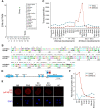Germ cell-specific eIF4E1b regulates maternal mRNA translation to ensure zygotic genome activation
- PMID: 37257918
- PMCID: PMC10270193
- DOI: 10.1101/gad.350400.123
Germ cell-specific eIF4E1b regulates maternal mRNA translation to ensure zygotic genome activation
Abstract
Translation of maternal mRNAs is detected before transcription of zygotic genes and is essential for mammalian embryo development. How certain maternal mRNAs are selected for translation instead of degradation and how this burst of translation affects zygotic genome activation remain unknown. Using gene-edited mice, we document that the oocyte-specific eukaryotic translation initiation factor 4E family member 1b (eIF4E1b) is the regulator of maternal mRNA expression that ensures subsequent reprogramming of the zygotic genome. In oocytes, eIF4E1b binds to transcripts encoding translation machinery proteins, chromatin remodelers, and reprogramming factors to promote their translation in zygotes and protect them from degradation. The protein products are thought to establish an open chromatin landscape in one-cell zygotes to enable transcription of genes required for cleavage stage development. Our results define a program for rapid resetting of the zygotic epigenome that is regulated by maternal mRNA expression and provide new insights into the mammalian maternal-to-zygotic transition.
Keywords: Eif4e1b; maternal RNA translation; mouse embryo; zygotic genome activation.
Published by Cold Spring Harbor Laboratory Press.
Figures







Similar articles
-
Degradation and translation of maternal mRNA for embryogenesis.Trends Genet. 2024 Mar;40(3):238-249. doi: 10.1016/j.tig.2023.12.008. Epub 2024 Jan 22. Trends Genet. 2024. PMID: 38262796 Review.
-
A story of birth and death: mRNA translation and clearance at the onset of maternal-to-zygotic transition in mammals†.Biol Reprod. 2019 Sep 1;101(3):579-590. doi: 10.1093/biolre/ioz012. Biol Reprod. 2019. PMID: 30715134 Review.
-
Profiling and functional characterization of maternal mRNA translation during mouse maternal-to-zygotic transition.Sci Adv. 2022 Feb 4;8(5):eabj3967. doi: 10.1126/sciadv.abj3967. Epub 2022 Feb 2. Sci Adv. 2022. PMID: 35108058 Free PMC article.
-
Selective Translation of Maternal mRNA by eIF4E1B Controls Oocyte to Embryo Transition.Adv Sci (Weinh). 2023 Apr;10(11):e2205500. doi: 10.1002/advs.202205500. Epub 2023 Feb 8. Adv Sci (Weinh). 2023. PMID: 36755190 Free PMC article.
-
The conserved regulatory basis of mRNA contributions to the early Drosophila embryo differs between the maternal and zygotic genomes.PLoS Genet. 2020 Mar 30;16(3):e1008645. doi: 10.1371/journal.pgen.1008645. eCollection 2020 Mar. PLoS Genet. 2020. PMID: 32226006 Free PMC article.
Cited by
-
Human Tissues Exhibit Diverse Composition of Translation Machinery.Int J Mol Sci. 2023 May 6;24(9):8361. doi: 10.3390/ijms24098361. Int J Mol Sci. 2023. PMID: 37176068 Free PMC article.
-
Stromal Pbrm1 mediates chromatin remodeling necessary for embryo implantation in the mouse uterus.J Clin Invest. 2024 Mar 1;134(5):e174194. doi: 10.1172/JCI174194. J Clin Invest. 2024. PMID: 38426493 Free PMC article.
-
The RNA-binding protein Adad1 is necessary for germ cell maintenance and meiosis in zebrafish.PLoS Genet. 2023 Aug 8;19(8):e1010589. doi: 10.1371/journal.pgen.1010589. eCollection 2023 Aug. PLoS Genet. 2023. PMID: 37552671 Free PMC article.
-
Oocyte-specific deletion of eukaryotic translation initiation factor 5 causes apoptosis of mouse oocytes within the early-growing follicles by mitochondrial fission defect-reactive oxygen species-DNA damage.Clin Transl Med. 2024 Aug;14(8):e1791. doi: 10.1002/ctm2.1791. Clin Transl Med. 2024. PMID: 39113233 Free PMC article.
-
ZNHIT3 Regulates Translation to Ensure Cell Lineage Differentiation in Mouse Preimplantation Development.Adv Sci (Weinh). 2025 Jun;12(21):e2413599. doi: 10.1002/advs.202413599. Epub 2025 Apr 3. Adv Sci (Weinh). 2025. PMID: 40178020 Free PMC article.
References
-
- Alda-Catalinas C, Bredikhin D, Hernando-Herraez I, Santos F, Kubinyecz O, Eckersley-Maslin MA, Stegle O, Reik W. 2020. A single-cell transcriptomics CRISPR-activation screen identifies epigenetic regulators of the zygotic genome activation program. Cell Syst 11: 25–41.e9. 10.1016/j.cels.2020.06.004 - DOI - PMC - PubMed
Publication types
MeSH terms
Substances
LinkOut - more resources
Full Text Sources
Molecular Biology Databases
